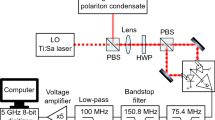Abstract
SONOLUMINESCENCE1–13 is a non-equilibrium phenomenon in which the energy in a sound wave becomes highly concentrated so as to generate flashes of light in a liquid. We show here that these flashes, which comprise over 105 photons, are too fast to be resolved by the fastest photomultiplier tubes available. Furthermore, when sonoluminescence is driven by a resonant sound field, the bursts can occur in a continuously repeating, regular fashion. These precise 'clock-like' emissions can continue for hours at drive frequencies ranging from audible to ultrasonic. These bursts represent an amplification of energy by eleven orders of magnitude
This is a preview of subscription content, access via your institution
Access options
Subscribe to this journal
Receive 51 print issues and online access
$199.00 per year
only $3.90 per issue
Buy this article
- Purchase on Springer Link
- Instant access to full article PDF
Prices may be subject to local taxes which are calculated during checkout
Similar content being viewed by others
References
Walton, A. J. & Reynolds, G. T. Adv. Phys. 33, 595–660 (1984).
Verral, R. E. & Sehgal, C. Sonoluminescence In Sonochemistry: Its Chemical and Physical Biological Effects (ed. Suslick, K. S.) (VCH, New York, 1988).
Suslick, K. Science 247, 1439–1445 (1990).
Frenzel, H. & Schultes, H. Z. phys. Chem. B27, 421–424 (1934).
Richards, W. T. & Loomis, A. L. J. Am. chem. Soc. 49, 3086–3100 (1927).
Schmitt, F. O., Johnson, C. H. & Olson, A. R. J. Am. chem. Soc. 51, 370–375 (1929).
Beuthe, H. Z. phys. Chem. 163, 161–171 (1932).
Saksena, T. K. & Nyborg, W. L. J. chem. Phys. 53, 1722–1733 (1970).
Crum, L. A. & Reynolds, G. T. J. acoust. Soc. Am. 78, 137–139 (1985).
Gaitan, D. F. thesis, Univ. of Mississippi (1990).
Gaitan, D. F. & Crum, L. A. Proc. 12th int. Symp. Nonlinear Acoustics (Elsevier, New York, in the press); Proc. Joint ASME-JSME Fluid Engng. Conf. Micro Fluid Mechanics (ASME, New York, in the press); J. acoust. Soc. Am. Suppl. 1, 87, S141 (1990).
Halford, G. R. thesis, Univ. of Illinois, (1966).
Erber, T. & Guralnick, S. A. Ann. Phys. 181, 25–53 (1988).
Margulis, M. A. Ultrasonics 23, 157–168 (1985).
Suslick, K. J. acoust. Soc. Am. 89, S1885 (1991).
Kurochkin, A. K., Smordov, E. A., Valitov, R. V. & Margulis, M. A. Russ. J. Phys. Chem. 60, 731–734 (1986); Zh. fiz. Khim. 60, 1234–1238 (1986).
Dicke, R. H. Phys. Rev. 93, 99–110 (1954).
Bonifacio, R. & Lugiato, L. A. Phys. Rev. A11, 1507–1521 (1975).
Suslick, K. S. Nature 330, 553–555 (1987).
Author information
Authors and Affiliations
Rights and permissions
About this article
Cite this article
Barber, B., Putterman, S. Observation of synchronous picosecond sonoluminescence. Nature 352, 318–320 (1991). https://doi.org/10.1038/352318a0
Received:
Accepted:
Issue Date:
DOI: https://doi.org/10.1038/352318a0
This article is cited by
-
In vivo ultrasound-induced luminescence molecular imaging
Nature Photonics (2024)
-
Single-pulse real-time billion-frames-per-second planar imaging of ultrafast nanoparticle-laser dynamics and temperature in flames
Light: Science & Applications (2023)
-
Free Boundary Problem for a Gas Bubble in a Liquid, and Exponential Stability of the Manifold of Spherically Symmetric Equilibria
Archive for Rational Mechanics and Analysis (2023)
-
Sonochemical Mediated Synthesis of Iron Oxide (Fe3O4 and Fe2O3) Nanoparticles and their Characterization, Cytotoxicity and Antibacterial Properties
Journal of Cluster Science (2019)
-
A comparative study of flow induced by 1D, 2D and 3D ultrasounds
Science China Technological Sciences (2019)
Comments
By submitting a comment you agree to abide by our Terms and Community Guidelines. If you find something abusive or that does not comply with our terms or guidelines please flag it as inappropriate.



